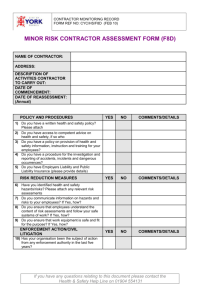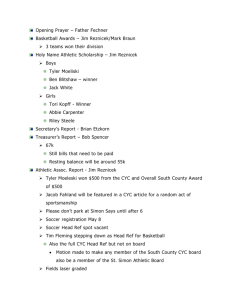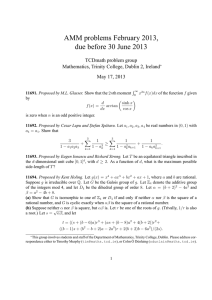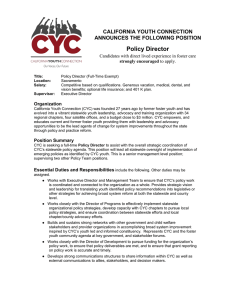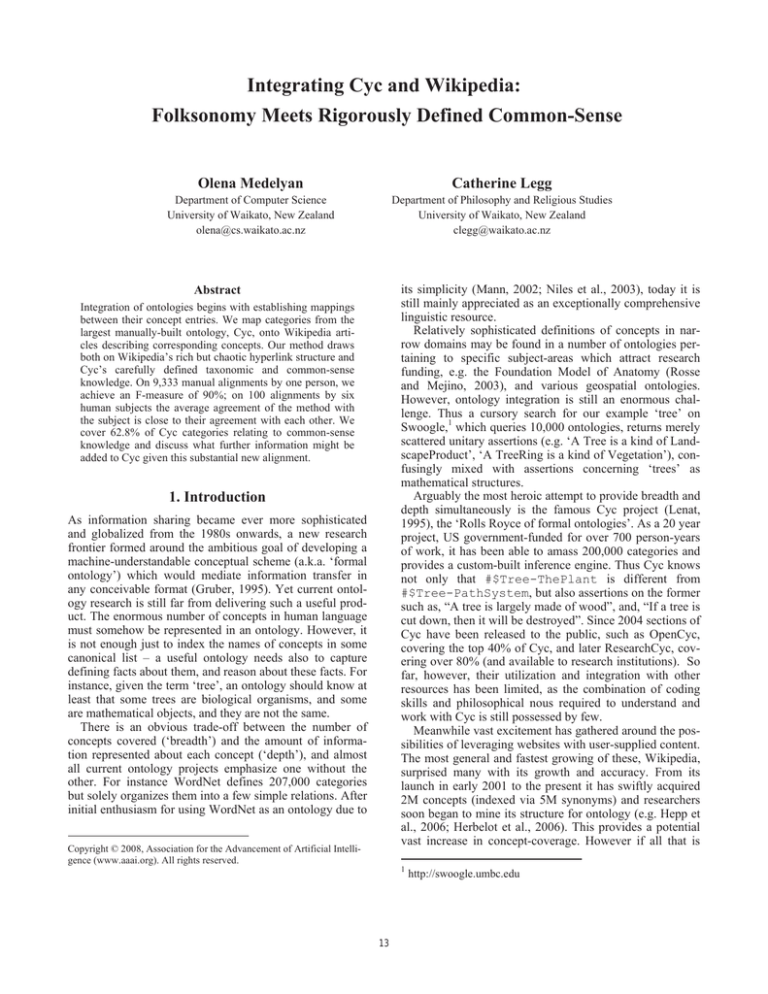
Integrating Cyc and Wikipedia:
Folksonomy Meets Rigorously Defined Common-Sense
Olena Medelyan
Catherine Legg
Department of Computer Science
University of Waikato, New Zealand
olena@cs.waikato.ac.nz
Department of Philosophy and Religious Studies
University of Waikato, New Zealand
clegg@waikato.ac.nz
its simplicity (Mann, 2002; Niles et al., 2003), today it is
still mainly appreciated as an exceptionally comprehensive
linguistic resource.
Relatively sophisticated definitions of concepts in narrow domains may be found in a number of ontologies pertaining to specific subject-areas which attract research
funding, e.g. the Foundation Model of Anatomy (Rosse
and Mejino, 2003), and various geospatial ontologies.
However, ontology integration is still an enormous challenge. Thus a cursory search for our example ‘tree’ on
Swoogle,1 which queries 10,000 ontologies, returns merely
scattered unitary assertions (e.g. ‘A Tree is a kind of LandscapeProduct’, ‘A TreeRing is a kind of Vegetation’), confusingly mixed with assertions concerning ‘trees’ as
mathematical structures.
Arguably the most heroic attempt to provide breadth and
depth simultaneously is the famous Cyc project (Lenat,
1995), the ‘Rolls Royce of formal ontologies’. As a 20 year
project, US government-funded for over 700 person-years
of work, it has been able to amass 200,000 categories and
provides a custom-built inference engine. Thus Cyc knows
not only that #$Tree-ThePlant is different from
#$Tree-PathSystem, but also assertions on the former
such as, “A tree is largely made of wood”, and, “If a tree is
cut down, then it will be destroyed”. Since 2004 sections of
Cyc have been released to the public, such as OpenCyc,
covering the top 40% of Cyc, and later ResearchCyc, covering over 80% (and available to research institutions). So
far, however, their utilization and integration with other
resources has been limited, as the combination of coding
skills and philosophical nous required to understand and
work with Cyc is still possessed by few.
Meanwhile vast excitement has gathered around the possibilities of leveraging websites with user-supplied content.
The most general and fastest growing of these, Wikipedia,
surprised many with its growth and accuracy. From its
launch in early 2001 to the present it has swiftly acquired
2M concepts (indexed via 5M synonyms) and researchers
soon began to mine its structure for ontology (e.g. Hepp et
al., 2006; Herbelot et al., 2006). This provides a potential
vast increase in concept-coverage. However if all that is
Abstract
Integration of ontologies begins with establishing mappings
between their concept entries. We map categories from the
largest manually-built ontology, Cyc, onto Wikipedia articles describing corresponding concepts. Our method draws
both on Wikipedia’s rich but chaotic hyperlink structure and
Cyc’s carefully defined taxonomic and common-sense
knowledge. On 9,333 manual alignments by one person, we
achieve an F-measure of 90%; on 100 alignments by six
human subjects the average agreement of the method with
the subject is close to their agreement with each other. We
cover 62.8% of Cyc categories relating to common-sense
knowledge and discuss what further information might be
added to Cyc given this substantial new alignment.
1. Introduction
As information sharing became ever more sophisticated
and globalized from the 1980s onwards, a new research
frontier formed around the ambitious goal of developing a
machine-understandable conceptual scheme (a.k.a. ‘formal
ontology’) which would mediate information transfer in
any conceivable format (Gruber, 1995). Yet current ontology research is still far from delivering such a useful product. The enormous number of concepts in human language
must somehow be represented in an ontology. However, it
is not enough just to index the names of concepts in some
canonical list – a useful ontology needs also to capture
defining facts about them, and reason about these facts. For
instance, given the term ‘tree’, an ontology should know at
least that some trees are biological organisms, and some
are mathematical objects, and they are not the same.
There is an obvious trade-off between the number of
concepts covered (‘breadth’) and the amount of information represented about each concept (‘depth’), and almost
all current ontology projects emphasize one without the
other. For instance WordNet defines 207,000 categories
but solely organizes them into a few simple relations. After
initial enthusiasm for using WordNet as an ontology due to
Copyright © 2008, Association for the Advancement of Artificial Intelligence (www.aaai.org). All rights reserved.
1
13
http://swoogle.umbc.edu
Strube (2006) categorize relations between Wikipedia categories by analyzing the names of concept pairs, their position in the network, as well as their occurrences in corpora,
to accurately label the relation between each pair as isa and
not-isa. However, there is yet no separation into further
types of relations, such as is-an-instance-of and has-part.
Also the approach is restricted to the 126,700 Wikipedia
‘categories’ (as opposed to the 2M Wikipedia articles).
Thus these approaches are still far from producing fullblooded ontologies.
Several authors explicitly look at mining Wikipedia as
an ontology. Hepp et al. (2006) use URIs of Wikipedia
entries as identifiers for ontological concepts. This provides WordNet-style breadth without depth. Herbelot et al.
(2006) extract an animal ontology from Wikipedia by parsing whole pages. Although they achieve an impressively
comprehensive coverage of their subject-matter, computational demands restricted the task to only 12,200 Wikipedia pages, a tiny fraction of the total.
Suchanek et al. (2007) create a new ontology, YAGO,
which unifies WordNet and Wikipedia providing 1M categories and 5M facts. Its categories are all WordNet synsets
and all Wikipedia articles whose titles are not listed as
common names in WordNet. It therefore misses many
proper names with homonyms in WordNet—e.g. the programming language Python and the film “The Birds”. Our
approach differs from Yago in that we identify links between synonymous concepts in Cyc and Wikipedia using
explicit semantic disambiguation, whereas Yago merely
adds Wikipedia to WordNet avoiding the ambiguous items.
The DBpedia project attempts to make all structured information in Wikipedia freely available in database form
(Auer et al., 2007). RDF triplets are extracted by mining
formatting patterns in the text of Wikipedia articles, e.g.
infoboxes, as well as categorization and other links. These
authors harvest 103M facts and enable querying of their
dataset via SPARQL and Linked Data. They also connect
with other open datasets on the Web. But this enormous
increase in data comes at a huge cost in quality. Many of
the triplets’ relations are not ontological but rather trivial,
e.g. the most common relation in infobox triplets (over
10%) is wikiPageUsesTemplate. Also, amongst the
relations that are ontological there are obvious redundancies not identified as such, e.g. placeOfBirth and
birthPlace, dateOfBirth and birthDate.
taken from Wikipedia are names for concepts, arranged in
a subsumption hierarchy via Wikipedia ‘category’ links, it
risks becoming another WordNet – merely a 10 times bigger bag of words with no real understanding of their meaning. What is needed is some way of adding definitional
information. One natural candidate for this is Cyc.
Given that Wikipedia has more concepts than Cyc, and
Cyc has a richer explicitly represented knowledge framework than Wikipedia, it makes sense to integrate Wikipedia concepts into Cyc, rather than vice versa. The starting
point for such integration is to establish mappings between
existing Cyc terms and corresponding Wikipedia articles.
To overcome terminology differences, we use rich synonymy relations in both resources. To deal with sense ambiguity, we analyze semantic similarity of possible mappings
to context categories in the neighboring Cyc ontology. To
bypass inconsistency in both resources, we develop a stepby-step mapping heuristic. With this strategy we can map
52,690 Cyc categories to Wikipedia articles, with a precision of 93% tested on 9,333 human alignments. Further
disambiguation based on Cyc’s common-sense knowledge
improves the precision of 42,279 mappings to over 95%.2
At each mapped node in Cyc’s tree, it may now be determined what new information Wikipedia can teach Cyc.
So far, we have managed to identify over 145,000 possible
new synonymy assertions, over 1,400 URLs, over 500,000
translations into other languages. We discuss the addition
of further facts, which would produce an enlarged ontology, which may then be used for further iterative ontology
alignment, including learning more facts from Wikipedia,
which continues to grow and improve.
2. Related work
On the Cyc side, from its inception Cycorp sought to map
existing ontologies and knowledge bases into Cyc, for instance WordNet (Reed et al. 2002). However having been
automatically entered the new information required cleaning and integrating by hand, which due to limited resources
was never done fully. Matuszek et al. (2005) extend Cyc
by querying a search engine, parsing the results, and
checking for consistency with the Cyc knowledge base.
However, they required a human check before each new
concept or fact was entered – thus only added 2,000 new
assertions. The Cyc Foundation3 is currently developing a
user-friendly interface to integrate Cyc and Wikipedia. So
far however (there are no published results yet), this appears to be merely a browser via which a human can look
at Cyc and Wikipedia categories side by side, rather than
any deeper integration.
On the Wikipedia side, mining for semantic relations is
the prevalent research topic. Gregorowicz et al. (2006)
treat Wikipedia as a semantic network, extracting hyperlinks between categories and articles, which are treated as
‘semantic’ but not further differentiated. Ponzetto and
2
3
3. Mapping of Cyc concepts to Wikipedia
The number of categories in our distribution of ResearchCyc (12/2007) is 163,317, however a significant portion of
these do not represent common-sense knowledge. We
therefore filtered out:
categories describing Cyc’s internal workings
knowledge required for natural language parsing
project-specific concepts
microtheories
predicates and all other instances of #$Relation
This leaves 83,897 categories.
Available here: http://www.cs.waikato.ac.nz/~olena/cyc.html
http://www.cycfoundation.org
14
•
•
We begin the integration of Cyc and Wikipedia by mapping Cyc concepts to Wikipedia articles. We do not allow
mappings to Wikipedia’s categories or disambiguation
pages, because the former do not specifically describe concepts and the latter are inconsistent, however we do use
disambiguation pages for identifying ambiguous terms (cf.
Section 3.2). To Cyc terms we apply a simple cleaning
algorithm to align them with Wikipedia article titles. This
includes splitting the name into component words while
considering the acronyms, e.g. #$BirdOfPrey → ‘Bird of
Prey’. Expressions after the dash sign in Cyc we write in
brackets as this is the convention in Wikipedia, e.g.
#$Virgo-Constellation → ‘Virgo (constellation)’. We
also map all but the first capitalized words to lower case,
since Cyc does not distinguish between these. For example,
in Wikipedia ‘Optic nerve’ (the nerve) and ‘Optic Nerve’
(the comic book) are distinct concepts; in Cyc the former is
encoded as #$OpticNerve and the latter is missing.
Next, we differentiate between two cases: first, where a
string comparison produces only one candidate Wikipedia
article per Cyc term (exact mapping), and second, where it
produces more than one (ambiguous mapping). For the
former we propose two steps that augment each other,
whereas for the latter we use two alternative approaches,
which we evaluate individually.
articles linked from matching redirects,
articles linked first in each disambiguation on
matching disambiguation pages.
We additionally utilize anchor names (i.e. hyperlinked
text) in Wikipedia as a source for synonyms (Mihalcea and
Csomai, 2007). Given a search term a, the likelihood it will
link to an article T is defined as
Commonness a ,T = P (T | a ) ,
which is the number of Wikipedia articles where a links to
T over the total number of articles linked from a. For example, the word Jaguar appears as a link anchor in
Wikipedia 927 times. In 466 cases it links to the article
Jaguar cars, thus the commonness of this mapping is 0.5.
In 203 cases it links to the description of Jaguar as an animal, a commonness of 0.22.
Thus, given a Cyc term, we add to its candidate set the 5
most common Wikipedia articles, and record the most
common link for each synonym of this term.
Disambiguation I: A simple disambiguation is to
weight each candidate article by the number of times it has
been chosen via the title of the Cyc term, or any of its synonyms. The highest weight indicates the ideal match.
Disambiguation II: Instead of relying on synonyms encoded in Cyc, this alternative disambiguation method is
based on the semantic similarity of each candidate article
to the context of the given Cyc concept. We define this
context using the Cyc ontology, retrieving the categories
immediately surrounding our candidate term with the following queries from Cyc’s inference engine:
MIN-GENLS – direct hypernyms (collection→collection)
MAX-SPEC – direct hyponyms (collection→collection)
GENL-SIBLINGS – sister collections of a given collection.
MIN-ISA – direct hypernyms (instance→collection)
MAX-INSTANCES –direct hyponyms (collection→instance)
ISA-SIBLINGS – sister instances for a given instance.
We retrieve additional context terms via assertions on selected Cyc predicates, for instance #$conceptually
Related, and the geographic #$countryOfCity.
In Cyc, specifications of a term’s meaning are often provided after a dash – e.g. #$Tool-MusicGroup, and
#$PCS-Corporation. If such a specification is parsed
and mapped to a Wikipedia article, it serves as a context
term as well. For example, ‘Music group’ helps mapping
#$Tool-MusicGroup to ‘Tool (band)’ in Wikipedia.
Next, for each context term obtained from Cyc, we identify a corresponding Wikipedia article with Mapping I and
II (Section 3.2) or ignore it if it is ambiguous.4 Given a set
of candidate Wikipedia articles and a set of related context
articles, we determine the candidate that is most semantically related to a given context (Milne and Witten, 2008).
For each pair, candidate article x and context article y, we
retrieve the sets of hyperlinks X and Y to these articles, and
compute their overlap X∩Y. Given the total number N of
articles in Wikipedia, the similarity of x and y is:
3.1 Exact mappings
Mapping 1: We identify Cyc terms which exactly match
Wikipedia article titles—or redirects, in which case the
target article is retrieved. If the match is to a disambiguation page, the term is treated as ambiguous and not considered. The result is a set of possible mappings for each Cyc
term. At this stage we only allow a mapping if this set contains exactly one member.
Mapping 2: If for a Cyc term Mapping 1 gives no results,
we check whether its synonyms exactly match a title of a
Wikipedia article, or its redirect. Again, only unitary result
sets are allowed.
With this exact mapping we linked 33,481 of the chosen
83,897 Cyc terms to Wikipedia articles (40%).
3.2 Ambiguous mappings
While the above mappings ensure high accuracy (cf. Section 4.1), their coverage can be improved because many
Cyc terms map to more than one Wikipedia article. Also,
where no mappings were found, a less strict string comparison can improve the coverage. Therefore, before proceeding with disambiguation, we use the following conflation strategy. To each Cyc term and Wikipedia title, we
apply case folding and remove brackets that specify the
term’s meaning (a feature used inconsistently in both resources). We do not use stemming, because most common
syntactic variations are covered in either resource. We now
begin to make use of links to articles on disambiguation
pages as well. The set of candidate Wikipedia articles for
each Cyc term now consists of:
• articles with matching titles
4
Although some important information is discarded by doing so,
we find that usually sufficient non-ambiguous terms are provided.
15
max(log | X |, log | Y |) − log | X ∩ Y | .
N − min(log | X |, log | Y |)
For each article in the set of possible mappings, we compute its average similarity to the context articles. If for all
candidates, no similarity to the given context is observed,
we return the candidate with the highest commonness
weight. Otherwise, we multiply the article T’s average
similarity to the context articles by its commonness given
the n-gram a:
SIM x , y = 1 −
Score( a, T ) =
∑ SIM
proven are retained. The following example lists Cyc terms
mapped to article ‘Casino’ and their scores:
1.1
1.0
0.4
0.1
The similarity test leaves us with #$Casino-Object and
#$Casino-TheMovie, where the former is more likely.
But Cyc knows that a casino is a #$SpatialThing and a
movie is an #$AspatialThing and the two are disjoint.
Thus we only accept #$Casino-Object, which is the
#$Casino-Object
#$Casino-TheMovie
#$Casino-TheGame
#$Casino-Organization
T ,c
× Commonnessa ,T ,
|C |
where c ∈ C are context articles for T. The article with the
highest score is the best candidate.
With this method we cover an additional 19,209 Cyc
terms (23%). This gives us the maximum coverage for the
proposed mapping strategy, a total of 52,690 mappings, i.e.
62.8% of Cyc’s common-sense knowledge. However, inaccuracies are inevitable. The following section describes
how we address them.
c∈C
correct mapping. The philosophical purity of Cyc’s ontology can produce some remarkable discriminations. For
instance, Cyc distinguishes between #$ValentinesCard
and #$ValentinesDay given that the former generalizes
to #$SpatialThing-NonSituational and the latter to
#$Situation.
Alternatively, the test allows both of these mappings:
#$BlackPeppercorn→‘Black pepper’
#$Pepper-TheSpice→‘Black pepper’
This is correct as the Wikipedia article, despite its title, is
more general than both Cyc terms, explaining how the
spice (both black and white) is produced from the peppercorns. The strategy does make some mistakes. For instance
having decided that #$Countess→‘Count’ has greater
semantic similarity than #$Count-Nobleman →‘Count’,
the method then proceeds to reject #$Count-Nobleman
(which would in fact be a better match) because Cyc’s collections of females and males are disjoint.
With this strategy we eliminate approximately 10K
mappings, which gives us a total of 42,279 − 50% of the
original 83,897. Next we evaluate, whether the precision of
these mappings is improved.
3.3 Common-Sense Disambiguation
After mapping all Cyc terms to Wikipedia articles, we find
cases where several Cyc terms map to the same article.
(This is the reverse of the problem addressed by Disambiguation I and II above, where several Wikipedia articles
map to the same Cyc term.) Analysis has shown that in
some cases, the differentiation in Cyc is too specific, and
both mappings are correct, e.g.#$ThoracicVertebra
and #$ThoracicVertebrae. In other cases, one or more
of the mappings are incorrect, e.g. #$AlJazeerahTheNewspaper→‘Al Jazeera’ and #$AlJazeeraMediaOrganizaton→ ‘Al Jazeera’ − since Wikipedia
describes the Al Jazeera TV network. Thus we perform
two consecutive tests to further correct such mappings.
1. Similarity test.
First, we examine the semantic similarity score of each
mapping. The best scoring mapping determines the minimum score for other mappings to be considered. A candidate is not considered if its score is over 30% lower than
the maximum score. This helps to eliminate many unlikely
mappings that were only ‘found’ because the Cyc concept
has no equivalent Wikipedia article, or it was not located.
For example, we eliminate #$PCS-Corporation →‘Personal Computer’ with a score 0.13, because it is lower than
1.58, the score of the best mapping: #$PersonalComputer→‘Personal Computer’.
2. Disjointness test.
If the above test still leaves more than one possible
mapping, we leverage Cyc’s common sense knowledge
about ‘different kinds of things’, represented in its extensive knowledge about disjointness of collections. We ask
Cyc, whether two candidate Cyc terms (or in the case of
individuals, their direct hypernyms) are disjoint. Any mapping which is disjoint with our highest scoring candidate is
eliminated. All mappings for which disjointness can not be
4. Evaluation
We evaluate the proposed methods using two data sets.
The first (Testset1), kindly offered to us by the Cyc Foundation, contains 9,436 synonymous mappings between Cyc
categories and Wikipedia articles − created semiautomatically by one person. Evaluation is made more difficult by the fact that at times more than one answer can be
correct (e.g. #$BabyCarrier can be mapped to either
‘Baby sling’ or ‘Child carrier’). Therefore we also investigate human inter-agreement on the mapping task by giving
a new set (Testset2) with 100 random Cyc terms to 6 human subjects. The goal of the algorithm is to achieve as
high agreement with the subjects as they with each other.
4.1 Results for Testset1
Out of 9,436 examples in the first data set, we exclude
Found
Correct
P
R
F
Mapping I
4655
4477
96.2 48.0
64.0
Mapping I & II
6354
5969
93.9 64.0
76.1
Table 1. Results for non-ambiguous mappings in Testset1:
precision (%), recall (%), F-Measure (%).
16
Before common-sense disambiguation
After common-sense disambiguation
Found
Correct P
R
F
Found
Correct P
R
F
Synonym-based
8884
7958
89.6
85.3
87.4
7715
7022
91.0
72.5
82.4
Context-based
8657
8054
93.0
7763
7386
79.1
86.4
86.3
89.5
95.1
Table 2. Results for disambiguated mappings in Testset1: precision (%), recall (%), F-Measure (%).
those that link to Wikipedia categories or particular parts
of Wikipedia articles. Tables 1 and 2 investigate mapping
of the remaining 9,333. Our Mapping I alone covers 4,655
examples, out of which 4,477 are correct. Moreover, manual examination of the ‘incorrect’ mappings reveals that
their vast majority is actually correct—our method often
identified more precise mappings than the given ones, e.g.:
• #$Plumage → ‘Plumage’ instead of ‘Feather’
• #$TransportAircraft → ‘Transport aircraft’
instead of ‘Cargo aircraft’
By including synonyms listed in Cyc in Mapping II, we
found an additional 1,699 mappings with 1,492 correct
according to the test set (precision 87.8%). Here often ‘incorrect’ mappings occur because the meaning is too close.
For example, the Cyc term #$SacAndFoxLanguage was
mapped to ‘Fox (tribe)’, via Cyc’s synonym sac and fox.
which in Wikipedia means the tribe. However, in the majority of cases this strategy worked well, e.g. #$AeolicGreekDialect → aeolic greek → ‘Aeolic Greek’.
The last row of Table 1 summarizes the results of Mappings I and II combined. We covered 68% of the test set
with precision of almost 94%. The remaining 32% of the
test set, 2,979 terms, are either difficult to find or ambiguous. With the stronger conflation strategies (cf. Section
3.2), we identify an additional bulk of terms with at least
one mapping and disambiguate them to Wikipedia articles
with our two methods: synonym-matching vs. contextbased similarity. We additionally evaluate, whether common-sense disambiguation (Section 3.3) improved the accuracy as expected. Table 2 compares the performance of
the algorithm under each setting, giving the overall results,
when disambiguation is combined with Mapping I and II.
Context-based disambiguation clearly outperforms the
synonym-based approach and achieves maximum precision
of 95.1%, when the disjointness test is used. The best recall, 86.3%, is achieved without the common-sense disambiguation, however the precision is more than 2 points
lower. There is an obvious trade-off between precision and
recall, and for some applications one could be more important than the other.
Manual analysis of errors shows different reasons for in-
correct mappings, e.g. inaccuracies in Wikipedia, errors in
the test set, insufficient context, very close meanings, or
inconsistencies in Cyc. For instance, insufficient context
led to erroneous mapping #$AnticommunistIdeology→‘Communism’, because it is more common than
‘Anti-Communism’. Sometimes, very similar meanings
could not be differentiated, e.g. #$CityOfKyotoJapan
and #$Kyoto-PrefectureJapan are both mapped to
‘Kyoto’. Both pages have high similarity with their context, whereas ‘Kyoto Prefecture’ is less a common page.
Treating specification after the dash sign as context and not
as a part of the title, results in #$Tea-Iced→‘Tea’ instead
of ‘Iced tea.’ This is an example of inconsistency in Cyc.
4.2 Results for Testset2
We created a second test set with 100 random Cyc categories, which six human subjects independently mapped to a
Wikipedia articles. The instructions were to map only if
both resources define the same concept, with the aid of the
Wikipedia search function.
Interestingly, the number of mapped concepts varied
across the subjects. All agreed that there is no mapping in
only 22 cases. On average they mapped 56 Cyc terms,
ranging from 47 to 65. The algorithm was again tested with
and without the common-sense disambiguation, where the
former mapped 58 and the latter only 39 terms. Note that
the creator of Testeset1 did not include ‘mappings’ where a
Cyc term had no corresponding Wikipedia article, whereas
Testset2 was created randomly from all common-sense
terms in Cyc. This is why both humans and the algorithm
have lower coverage on this set.
To compute the agreement we compared mapped concepts between each pair of human subjects, and between
each human subject and our algorithm. Table 3 summarizes the results. The overall agreement between our subjects is 39.8%. The surprisingly low coverage of the algorithm, when common-sense disambiguation is applied,
results in very low agreement on this data set of only
29.7%. However, without this test the algorithm performs
nearly as well as the human subjects (39.2%). In fact, it
outperforms Subjects 1 and 6.
Error analysis shows that in some cases the algorithm
picked a more general article than the humans, e.g.
#$Crop→‘Agriculture’, instead of ‘Crop (agriculture)’,
picked by all subjects, or #$StarTrek-GameProgram
→‘Star Trek’, instead of ‘Star Trek Games’, as identified
by one subject, or ‘Star Trek Generation (video game)’, by
another, while the others failed to produce any mapping. In
a few cases, the algorithm identified a mapping where most
humans failed, e.g. #$BurmesePerson→‘Bamar’.
Agreement
Agreement with algorithm
with other
before final
after final
subjects
disambiguation
disambiguation
Subject 1
37.6
34.0
28.0
Subject 2
40.4
41.0
31.0
Subject 3
40.8
40.0
29.0
Subject 4
40.8
41.0
30.0
Subject 5
42.4
44.0
32.0
Subject 6
37.0
35.0
28.0
Overall
39.8
39.2
29.7
Table 3. Results for the final mapping algorithm on Testset2.
17
5. Adding new information to Cyc
References
Now that the alignment has been performed, could any
new information be added to Cyc from Wikipedia?
Synonyms: Despite the extensive work on its natural
language interface, Cyc is weak at identifying its concepts.
For instance, typing “Casino” into Cyc’s search function
does not retrieve #$Casino-TheMovie. Given 42,279
more accurate mappings, we can retrieve over 154,800
synonyms from Wikipedia (≈2.6 per term), of which only
8,390 are known by Cyc.
Translations: Currently, there are over 200 different
language versions of Wikipedia. 15 versions have over
100,000 articles, and 75 have at least 10,000. We have
estimated that given 42,836 mappings of Cyc terms to
Wikipedia articles, we can retrieve over 500,000 translations of these terms in other languages, which is about 13
per term.
Glosses: For each mapping we can retrieve the first paragraph of Wikipedia’s article, which would enrich Cyc’s
hand-written #$comment on that term.
URL Resources: Using triplets in DBpedia’s infobox
dump, we identified 1,475 links to URLs corresponding to
the Wikipedia concepts that we have mapped to Cyc.
New Relations: Many other relations in the DBpedia
dataset bear a significant similarity to Cyc predicates, e.g.:
keyPeople ↔ #$keyGroupMembers
capital ↔ #$capitalCity
However manual analysis has shown that much of the
dumped data is of poor quality (e.g. keyPeople assertions
of the form “CEO” or “Bob”, capital assertions which
name districts rather than cities). Much however could be
done to automatically quality-control candidate assertions
using Cyc’s ontological constraints on the arguments of its
predicates – thus for instance as Cyc knows that the first
argument to #$capitalCity must be a #$City, it can
reject the claim that the capital of Bahrain is #$AlManamahDistrict. We will explore this in future work.
Auer, S.; Bizer, C.; Kobilarov, G.; and Lehmann, C. et al.
2007. DBPedia: A nucleus for a Web of open data. Aberer,
K. et al (eds.) ISWC/ASWC 2007, LNCS 4825. SpringerVerlag, Berlin Heidelberg, pp. 722-35.
Gregorowicz, A.; and Kramer, M.A. 2006 Mining a largescale term-concept network from Wikipedia. Tech. report,
The MITRE Corporation.
Gruber, T.R. 1995. Toward principles for the design of
ontologies used for knowledge-sharing. Int. Journal of
Human and Computer Studies, 43 (5/6), 907-28.
Guarino, N. (1998). Formal ontology and information systems. Proc. FOIS-98, Trento, Italy.
Hepp, M.; Bachlechner, D.; and Siorpaes, K. 2006. Harvesting Wiki Consensus-Using Wikipedia Entries as Ontology. Proc. ESWC-06 Workshop on Semantic Wikis,
pp.132-46.
Herbelot, A.; and Copestake, A. 2006. Acquiring Ontological Relationships from Wikipedia Using RMRS. Proc.
ISWC-06 Workshop on Web Content Mining with Human
Language.
Legg, C. 2007. Ontologies on the Semantic Web. Annual
Review of Information Science and Technology 41, 407-52.
Lenat, D.B. 1995. Cyc: A Large-Scale Investment in
Knowledge Infrastructure. Communic. of the ACM 38 (11).
Mann, G.S. 2002. Fine-grained Proper Noun Ontologies
for Question Answering. Proc. ICCL-02, SEMANET:
Building and Using Semantic Networks, Vol. 11, 1-7.
Matuszek, C.; Witbrock, M.; Kahlert, R.C. et al. 2005.
Searching for Common Sense: Populating Cyc from the
Web. Proc. AAAI-05. Pittsburgh, Penn., pp.1430-1435.
Milne, D.; and Witten, I.H. 2008. An effective, low-cost
measure of semantic relatedness obtained from Wikipedia
links. Proc. AAAI-08 Workshop Wikipedia and the AI.
Mihalcea, R.; and Csomai, A. 2007. Wikify!: Linking documents to encyclopedic knowledge. Proc. CIKM-07, pp.
233-242.
Niles, I.; Pease, A. 2003. Linking Lexicons and Ontologies: Mapping WordNet to the Suggested Upper Merged
Ontology. Proc. IEEE IKE-03, pp. 412-416
Reed, S.; and Lenat, D.B. 2002. Mapping ontologies into
Cyc. Proc. AAAI Workshop Ontologies for the Semantic
Web, Edmonton, Canada.
Rosse C.; and Mejino J.V.L. 2003. A reference ontology
for biomedical informatics: the Foundational Model of
Anatomy. J Biomed Inform. 36:478-500.
Ponzetto, S. P.; and Strube, M. 2007. Deriving a Large
Scale Taxonomy from Wikipedia. Proc. of AAAI-07, pp.
1440-1445.
6. Conclusions
We map 52,690 Cyc terms to Wikipedia articles, with a
precision of 93%. Evaluation shows that this mapping
technique achieves the same agreement with 6 human subjects as they do with each other. We also show how more
accurate results can be achieved using Cyc’s commonsense knowledge.
Our work opens up considerable possibilities for further
enriching Cyc’s ontological rigor with Wikipedia’s folksonomic bounty.
Acknowledgements
We thank Mark Baltzegar, Sudarshan Palliyil, Tim Wilmot-Sitwell, Glen Meyer, Kendall Lister, Brett Summers,
Marios Daoutis and Cycorp Inc. for their generous help
with this research.
18

